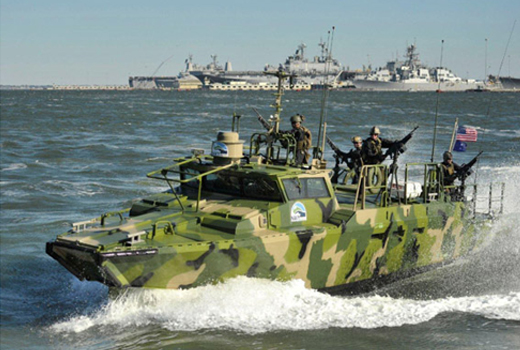The U.S. Navy’s Sustainability Imperative
In the second decade of the 21st Century an emergent concern is rapidly assuming a central position in the Navy, national and global consciousness. It is “sustainability.” Defined in various ways, the term invariably connotes both awareness of the effects of current and past practices on society, the economy and the environment, and a commitment to ameliorate negative effects so as to maintain or to improve upon current quality of life.
Today, sustainability is a key concern in many segments of society. The year 2011 has seen intense debate over sustainability of the nation’s and the international community’s fiscal practices. Sustainability of global energy sources, in particular petroleum, remains a significant concern both domestically and internationally. Long-term supply of rare earth metals, vital to production of high-tech devices essential in the information age, is also an emerging sustainability concern. For the United States Navy, continued access to traditional training, testing and operating areas in the face of increasing competition from various other important national interests has made sustainability a front burner issue.
The U.S. Navy is a national leader in the transformation of energy use to achieve a more sustainable future. For ships, planes and installations, the Navy is implementing a Spartan energy ethos wherein energy is valued as a strategic resource, and conservation and efficiency are central considerations. At the point of the national spear in dealing with international crises, the Navy is well aware of the vulnerability of the U.S. energy supply, in particular with regard to its national dependence on oil. As a consequence, enhancing the nation’s energy security by reducing that vulnerability is a key priority. In concert with other Federal agencies, academia and private industry, the Navy is leading the way toward a more sustainable energy future through development of renewable alternatives to petroleum. The Navy is also focused on sustainable and affordable electrical energy generation through sensible, fiscally intelligent use of solar, wind, tidal, geothermal and other energy sources.
While supporting the nation’s need to develop new energy sources as a means of improving its energy and economic security, in some instances these priorities have created tension between renewable energy development and robust military testing and training. Offshore oil and gas development, and future wind energy projects, could potentially obstruct existing military training areas and/or create interference with radar systems used for testing and training as well as homeland defense. Ashore, solar towers constructed in proximity to air corridors could create obstructions and/or reflection issues, which could degrade air navigation. Additionally, new wind turbines – some reaching 600 or more feet into the air – could create obstruction and interference challenges for military training and testing at existing bases and range areas.
The challenge is to find solutions that will enable the nation’s development of needed energy and other infrastructure while enabling the Navy to carry out its national defense mission through continuous training and testing at sea, ashore and in the air. Towards these objectives, as discussed below, a number of initiatives are underway at the national level within the Department of Defense (DoD) and within the Department of the Navy (DON). The Navy’s active participation in these initiatives, and forward-leaning approach to its own energy requirements, will help ensure a sustainable future for the Navy and the nation.
Coastal and Marine Spatial Planning
In July 2010 the President issued Executive Order 13547, entitled “Stewardship of the Ocean, Our Coasts and the Great Lakes.” The Order adopted the recommendations of an Interagency Ocean Policy Task Force, established the previous year, which worked diligently to develop a consensus statement of U.S. national policy regarding ocean, coastal and Great Lakes waters. The Task Force also worked to identify national priority objectives for the management and sustainment of these areas. Among these priorities is the use of ecosystem-based management rather than management focused on protecting a single species or reducing a specific kind of pollution. Another key priority is the synthesis of all existing ocean information collection systems into a national system, thereby enabling better informed decision making about ocean issues. The adoption of Coastal and Marine Spatial Planning (CMSP) is yet another key priority and one that bears directly upon the sustainability of Navy and many other interests at sea.

© iStockphoto.com/RainervonBrandis
The objectives of CMSP are to support sustainable, secure, efficient and productive uses of the nation’s oceans, coasts and Great Lakes, thus taking into account current and future requirements of economy, commerce, recreation, conservation, homeland and national security, safety and welfare. Nine Regional Planning Bodies (RPB) have been established, which cover the United States exclusive economic zone, coastal areas and the Great Lakes. Each RPB has a Federal and a non-Federal co-chairperson. Members of the RPB are interested Federal and state agencies, and representatives of federally recognized tribes. The RPBs will function so that other interested parties, such as industry, academia and NGOs, can provide input to the process.
Once constituted, the RPBs will set to work developing Coastal and Marine Spatial (CMS) Plans. Drawing upon all available information, these plans will seek to harmonize human use of the oceans, coastal areas and the Great Lakes. The RPBs will also develop environmental impact analysis documentation for the plan. Completed plans will be sent to the National Oceans Council (NOC) for approval. Once approved, the plans will guide future Federal agency activities in the respective areas. Existing Federal and state legal requirements, however, will remain unchanged.
The Department of Defense (DOD) and the Joint Chiefs of Staff (JCS) are assigned a seat on each RPB. Navy and other military services will represent the DOD and JCS on the various RPBs. Commander, Navy Region Southeast will serve as the Federal co-chair of the South Atlantic RPB. A DOD and JCS NOC Executive Steering Group (ESG) has been created to coordinate actions of the DOD/JCS RPB members and to support NOC activities at the headquarters level. The ESG is jointly chaired by the Assistant Secretary of the Navy (Energy, Installations & Environment), acting for the Secretary of Defense, and the Navy Judge Advocate General, acting for the Joint Chiefs of Staff. The ESG will act as a clearinghouse for information within DOD on NOC issues, coordinate the military services’ positions on NOC issues and ensure policy consistency among the military representatives to the various RPBs.
The RPBs will begin their work in earnest in the fall of 2011. The challenges are daunting, given the magnitude of effort, diversity of stakeholders and importance of this effort to the very livelihoods of millions of Americans. Reductions in the Federal budget for Fiscal Year 2012 and beyond may create additional challenges. Still, initiation of the CMS planning effort is a landmark achievement in the nation’s effort to ensure long term sustainability of U.S. ocean resources.
Renewable Energy Project Siting
Within the past 10 years the nation has experienced a strong surge of interest in wind energy development. Although wind energy currently provides less than 3 percent of the nation’s electrical power, the trend is dramatically upward with 2010 U.S. wind power capacity more than 10 times the amount in 2000. The Department of Energy (DOE) goal is for 20 percent of U.S. electrical energy to be produced by wind power by 2030. While beneficial in terms of resource conservation, reducing carbon footprint and reducing the nation’s dependence on foreign sources of energy, wind energy does present certain compatibility challenges, in particular with respect to potential airspace obstruction and potential interference with radar systems.
Modern wind towers stand hundreds of feet tall – the blade tip of the tallest turbine currently in use is 673 feet above ground level. Available wind power increases with height above ground due to reduced turbulence and drag. Taller towers enable individual turbines to maximize energy production, hence the likelihood that turbine height will continue to increase. This trend, in addition to rapid growth of wind energy in the United States, creates the need for military services to coordinate with wind energy developers to ensure compatibility of wind energy projects with air operations at military bases and training areas.

© iStockphoto.com/ssuaphoto
Wind turbine height and spinning blades present various challenges to radar systems. Because turbines stand tall and are generally concentrated in groups, wind farms can create clutter on radar scopes, thus masking intended targets. Additionally, the spinning blade tips can appear as moving targets on some radar systems, which could be confused with moving aircraft. Certain upgrades and workarounds to radar systems exist that may reduce the impact of wind turbine interference, but at present no “silver bullet” exists, which completely eliminates all interference.
Against this backdrop of emerging compatibility challenges as between renewable energy projects and military activities, in January 2011 Congress enacted a law seeking to facilitate development of renewable energy projects while sustaining military training. Section 358 of the 2011 National Defense Authorization Act made support for renewable energy development an objective of the Department of Defense. It also created a Clearinghouse within the Office of the Secretary of Defense (OSD) to expedite military service review of certain renewable energy projects, in particular those that require review by the Federal Aviation Agency (FAA) because of their possible obstruction or radar interference with air navigation. The new law provides that only the Secretary of Defense or designated very senior OSD officials may register an official DOD objection to a renewable energy project and then only after giving full consideration to possible mitigation and still finding an unacceptable risk to the national security of the United States.
In the spring and summer of 2011 the DOD Siting Clearinghouse and military services together achieved a number of important milestones. The services carefully reviewed 250 renewable energy projects for compatibility with military operations and were able to clear on all but 20 projects. The services are in the process of reviewing the remaining 20 projects to determine with greater clarity their actual impact on military operations and whether mitigations exist that would make the project acceptable. During the balance of 2011, hundreds more projects will be reviewed through the Clearinghouse process. The Clearinghouse, with military service participation, also developed a Federal rule establishing procedures under which the wind energy developers and other stakeholders will interface with OSD and the services in ensuring compatible siting of renewable energy projects.
Navy’s Task Force Compatibility & Readiness Sustainment
Long before the establishment of the DOD Siting Clearinghouse, the Navy was actively addressing a host of compatibility issues. These include not only wind energy development, as discussed above, but also residential and commercial development near military bases, noise issues, apportionment of the electromagnetic spectrum for communication purposes, solar tower development and others. The increasing importance of these issues to ensuring sustainable military operations prompted the Navy in March 2011 to create the Navy Task Force Compatibility and Readiness Sustainment (TFCRS).
Chaired by the Deputy Chief of Naval Operations for Readiness and Logistics, TFCRS brings together Flag and Senior Executive Service leadership across the Navy to assess and to oversee the response to existing and future compatibility challenges. The Task Force will also coordinate development of Navy input to the NOC. Having a focal point for compatibility issues will improve and expedite informed decision making by the Navy, thus enabling decisive action on short-fused challenges while protecting key Navy training and testing equities.
Conclusion
Within the past several years, a sustainable economic, environmental, energy and natural resources future has become a principal concern of national leadership and opinion leaders in and out of government. Within DOD and the Navy, sustainability is understood in these terms and also with respect to sustaining readiness of military forces for employment in support of national policy objectives. Through active cooperation with national efforts, such as the National Ocean Council, and improved compatibility management efforts, such as the DOD Siting Clearinghouse and the Navy’s Task Force Compatibility and Readiness Sustainment, the Navy is helping to ensure that today’s Naval forces are combat ready while protecting the planet for future generations.

© iStockphoto.com/toneteamNo. 14, 2011





























